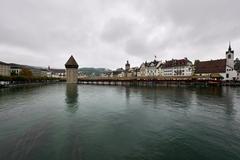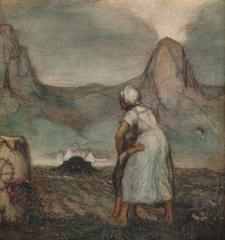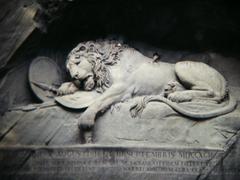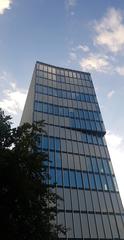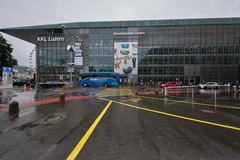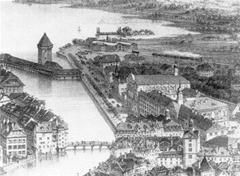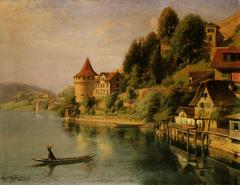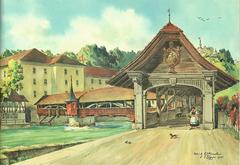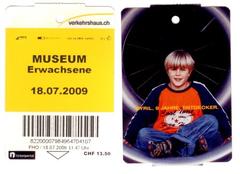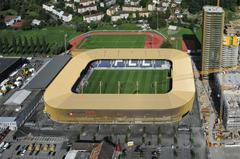Visiting the Former National Bank Building: Rosengart Collection Lucerne, Switzerland – Complete Guide
Date: 14/06/2025
Introduction
In the heart of Lucerne, the Former National Bank Building stands as a testament to the city’s architectural and cultural evolution. Once the regional Swiss National Bank headquarters (constructed 1923–1924 by architect Hermann Herter), the neoclassical structure is now home to the world-renowned Rosengart Collection museum. This transformation represents Lucerne’s broader commitment to heritage preservation, adaptive reuse, and the enrichment of urban culture (Diener Diener Architects; Swiss Inventory of Cultural Property).
Today, the Rosengart Collection invites visitors to explore over 300 masterpieces by artists such as Pablo Picasso and Paul Klee within an environment that blends historic grandeur with contemporary museology. This guide explores the building’s origins, architectural features, transformation into a museum, and provides all the practical information you need for your visit.
Table of Contents
- Historical Origins and Urban Context
- Architectural Features and Significance
- Transformation: Adaptive Reuse and Urban Renewal
- The Rosengart Collection: Museum Highlights
- Visitor Information
- Exploring Nearby Lucerne Attractions
- Frequently Asked Questions (FAQ)
- Tips for a Successful Visit
- Conclusion and Further Resources
Historical Origins and Urban Context
Lucerne’s strategic position at Lake Lucerne’s foot and proximity to the Alps contributed to its medieval commercial importance and subsequent urban expansion (Nomads Travel Guide). By the early 20th century, the city was thriving, with Belle Époque development adding residential and administrative buildings beyond the medieval core (Swiss National Museum Blog).
It was within this context that the Swiss National Bank commissioned a regional headquarters on Pilatusstrasse—a symbol of economic stability and civic ambition. The building’s neoclassical design reflected confidence in Switzerland’s financial future, while integrating harmoniously with Lucerne’s historic urban fabric (Diener Diener Architects).
Architectural Features and Significance
Exterior Design
The building’s symmetrical façade, robust local stonework, imposing columns, and decorative cornices are hallmarks of early 20th-century Swiss neoclassicism (facts.net). These classical motifs project permanence and trust, qualities essential to its original function as a major financial institution.
A distinctive gold-bronze frieze on the façade now lists the names of featured artists, signifying the building’s new identity as a cultural landmark.
Interior Spaces
Inside, high ceilings, marble floors, and intricate woodwork define the grand banking hall. The vaults—once the heart of secure banking operations—have been transformed into atmospheric exhibition spaces, blending security with aesthetic refinement (Rosengart Collection).
Transformation: Adaptive Reuse and Urban Renewal
In the late 1990s, architect Roger Diener led the adaptive reuse of the building, preserving its neoclassical exterior while modernizing the interiors to accommodate a world-class art collection (Springer). This project exemplifies sustainable urban renewal—conserving resources, reducing waste, and invigorating Lucerne’s city center with new cultural energy.
Adaptive reuse allowed for the integration of modern amenities, accessibility features, and state-of-the-art lighting, all while respecting the building’s original character (NY Times).
The Rosengart Collection: Museum Highlights
Permanent Collection
The Rosengart Collection is internationally recognized for its depth in Classical Modernism, with particular emphasis on:
- Paul Klee: 125 works, representing all phases of his career—watercolors, drawings, and paintings (myswitzerland.com).
- Pablo Picasso: 32 paintings and around 100 works on paper, with an emphasis on late-period pieces, accompanied by David Douglas Duncan’s intimate photographic portraits.
- Other Masters: Works by Claude Monet, Paul Cézanne, Henri Matisse, Joan Miró, Marc Chagall, and others, providing a comprehensive survey of early 20th-century art (Rosengart Collection Official Site).
Temporary Exhibitions and Events
The museum regularly hosts special exhibitions—often focused on thematic connections, new acquisitions, or artist-specific retrospectives. Annual exhibitions highlight Duncan’s photographs, while interactive events engage families and younger visitors (Rosengart Collection Events).
Visitor Information
Location and Accessibility
- Address: Pilatusstrasse 10, 6003 Lucerne, Switzerland
- Getting There: A 3-minute walk from Lucerne’s main railway station; close to Chapel Bridge and the Old Town (Lucerne Tourist Information).
- Accessibility: Fully wheelchair accessible with step-free entry, elevators, and adapted restrooms. The Lucerne Visitor Card offers free public transport for overnight guests (Lucerne Visitor Card).
Opening Hours and Tickets
- April – October: Daily, 10:00 AM – 6:00 PM
- November – March: Daily, 11:00 AM – 5:00 PM
- Closed: During Lucerne’s Fasnacht (Carnival)
Tickets
- Adults: CHF 21
- Students/Seniors/Groups: Reduced rates
- Children under 8: Free
Purchase tickets online (Rosengart Collection Official Website) or at the entrance. Online booking is advised during peak periods.
Facilities and Services
- Cloakroom/Lockers: Secure storage for personal items
- Museum Shop: Art books, postcards, and souvenirs
- Audio Guides: Available in multiple languages
- Guided Tours: Regularly scheduled in English and German; private tours by arrangement
- Dining: No on-site café; numerous cafés and restaurants nearby
Guided Tours and Educational Programs
- Private Tours: By advance booking, tailored in various languages
- Children’s Tours: “Children guiding children” (in German), discovery bags, and interactive materials (luzern.com)
Exploring Nearby Lucerne Attractions
The museum’s central location is ideal for exploring:
- Chapel Bridge (Kapellbrücke)
- Jesuit Church
- Musegg Wall and Towers
- Old Town’s murals and squares
- Lake Lucerne promenade
Combine your museum visit with a walking tour of Lucerne’s historical sites for a deeper cultural experience (Wonderful Wanderings: Lucerne; facts.net).
Frequently Asked Questions (FAQ)
Q: What are the museum’s opening hours?
A: April–October: 10:00–18:00; November–March: 11:00–17:00; closed during Fasnacht.
Q: How much is admission?
A: CHF 21 for adults; discounts for students, seniors, groups; free for children under 8.
Q: Is the building accessible for wheelchair users?
A: Yes, with step-free access, elevators, and accessible restrooms.
Q: Are guided tours available?
A: Yes, scheduled tours in German/English and private tours on request.
Q: Where can tickets be purchased?
A: Online via the official website or at the entrance.
Tips for a Successful Visit
- Timing: Visit on weekday mornings or late afternoons for fewer crowds.
- Duration: Allocate 1.5–2 hours to fully enjoy the collection and architecture.
- Museum Passes: The Lucerne Museum Pass and Swiss Museum Pass offer value if visiting multiple museums (luzern.com).
- Photography: Non-flash photography is generally allowed; check for signs in special exhibitions.
- Language: Audio guides and printed materials are available in English, German, and French.
Conclusion and Further Resources
The Former National Bank Building—now the Rosengart Collection—epitomizes Lucerne’s ability to preserve its historic character while fostering contemporary cultural life. Its adaptive reuse stands as a model of sustainable urban renewal, and its art collection offers a journey through the masterpieces of modernism. Centrally located and accessible, the museum is a highlight for anyone interested in art, history, or architecture.
For the latest updates, special events, and ticket information, refer to the Rosengart Collection Museum official website and the Lucerne Tourist Information portal.
For guided tours, event notifications, and personalized itineraries, download the Audiala app and follow us on social media.
References
- Diener Diener Architects: The Rosengart Collection
- Rosengart Collection: The Museum
- Swiss Inventory of Cultural Property: Lucerne
- Springer: Adaptive Reuse of Historic Bank Buildings
- myswitzerland.com: Sammlung Rosengart
- luzern.com: Museum Rosengart Collection
- Lucerne Tourist Information
- Swissinfo: Urban Planning
- facts.net: Luzern Facts
- Wonderful Wanderings: Lucerne
- NY Times: Historic Bank Buildings Get a Second Act
- Nomads Travel Guide: Lucerne Walking Tour
- Swiss National Museum Blog: Belle Epoque in Lucerne
